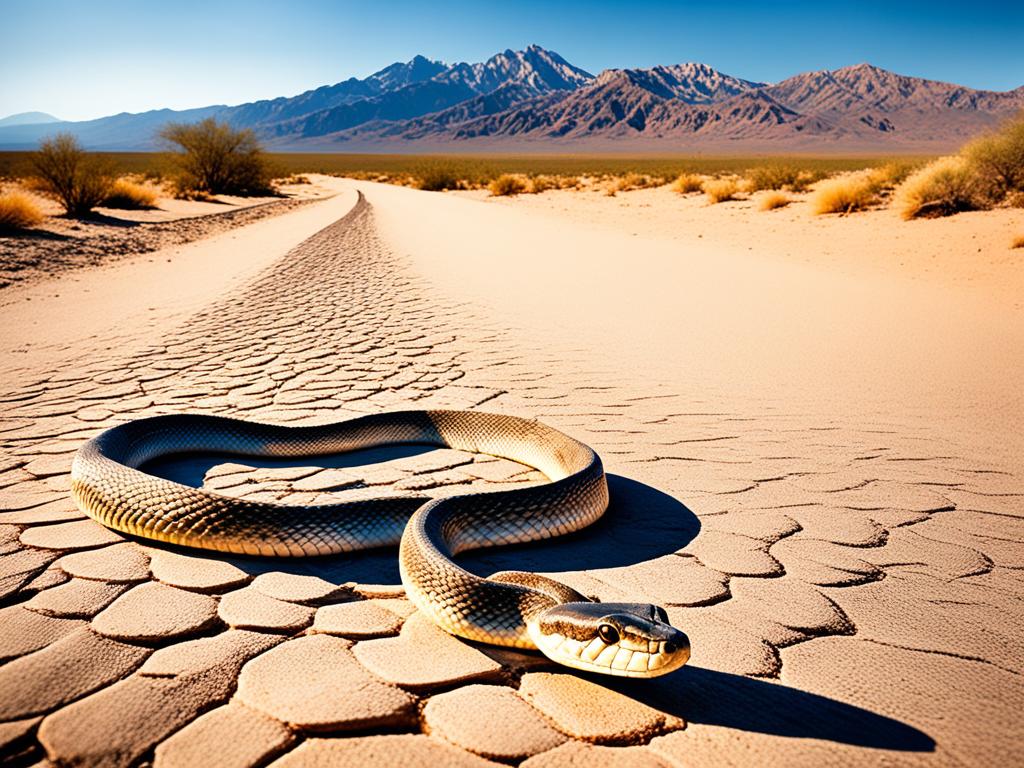In my exploration of how far do snakes travel, it’s fascinating to discover their impressive snake travel capabilities. While many may view these reptiles as slow and sluggish, some are truly remarkable in their ability to cover long distances when necessary. Factors that influence their travel range include habitat preferences, movement behaviors, and physiological needs. Snakes embark on journeys to find food, evade predators, or migrate with changing seasons. Through this article, I aim to shed light on the surprising distances these serpents can roam and the astonishing abilities that come with their unique physiology.
Table of Contents
Key Takeaways
- There are approximately 250 species and subspecies of snakes in the United States, with only four being venomous.
- Snakes can utilize different types of locomotion to travel, with many moving several miles when migrating.
- Smaller snake species migrate up to 1-3 miles, while larger ones can cover over 10 miles easily.
- Environmental factors, like food availability, significantly impact the travel distance of snakes.
- Some species, like sea snakes, have been recorded migrating distances of over 100 miles.
Understanding Snake Movement and Locomotion
Snakes possess an array of fascinating locomotion methods that allow them to traverse diverse environments effectively. Different types of snake locomotion can influence how far they can travel. I find it intriguing to explore these various mechanisms and the factors influencing snake movement.
Types of Snake Locomotion
There are several distinct types of snake locomotion, each enabling these creatures to move in their unique habitats. The primary modes include:
- Serpentine Locomotion: This is the most common method, where snakes move in a lateral, S-shaped pattern. This movement allows them to push against surfaces, aiding in their travel.
- Concertina Locomotion: Utilizing an accordion-like method, snakes anchor sections of their body and progressively contract to advance, often seen in tree-dwelling species.
- Rectilinear Locomotion: Mainly used by larger snakes, this technique involves slow, straight movements that minimize lateral motions, helping them navigate efficiently.
- Sidewinding Locomotion: Found in desert snakes, this method allows them to glide across sand or smooth surfaces with minimal friction.
This diversity in locomotion styles directly influences the distance snakes move, allowing them to adapt to various terrains, from forests to deserts.
Factors Influencing Snake Movement
Several factors significantly impact how far snakes can travel. Understanding these elements sheds light on the distance snakes move:
- Environmental Conditions: Weather and temperature play vital roles in determining a snake’s energy levels, directly affecting its locomotion.
- Habitat Availability: Snakes often travel more extensively in familiar environments where food resources are plentiful and safe, such as woodlands or wetlands.
- Species Variation: Different snake species exhibit varying movement capabilities, influenced by size, muscle structure, and ecological adaptations.
Recognizing these factors helps us appreciate the intricate ways that environmental elements interact with snake locomotion methods to influence how far they can travel.
How Far Do Snakes Travel?
Understanding how far snakes travel can offer insights into their behaviors, habitats, and survival strategies. The distance varies significantly based on species, environmental factors, and seasonal changes. While I often wonder about these fascinating creatures, the average distance snakes travel in a day typically ranges from 1 to 3 miles.
Average Distance Traveled Daily
In my exploration of snake movement, it’s clear that the average snake slither distance directly correlates with the species’ ecological needs. For instance, garter snakes can travel approximately 2 miles during their seasonal migrations while searching for new habitats. Corn snakes, on the other hand, usually move about 1 mile per day as they track prey. Some species, like rattlesnakes, demonstrate even more notable travel ranges, especially during mating seasons or when hunting.
Comparison of Different Species
When I compare different species of snakes, patterns in their travel distances emerge. The following highlights the variations:
| Species | Average Daily Travel Distance | Notes |
|---|---|---|
| Garter Snake | Up to 2 miles | Prominent migratory behavior |
| Corn Snake | About 1 mile | Primarily hunts for small prey |
| Rattlesnake | Variable, can exceed miles | Increased movement during mating |
This comparison illustrates how far do snakes travel varies widely among species, influenced by behavioral and ecological dynamics. Understanding these travel distances helps frame discussions about snake migration distance and their adaptation to different environments.

Behavioral Patterns Affecting Snake Travel Range
The movement of snakes offers a fascinating glimpse into their survival strategies, especially concerning their travel range influenced by various behavioral patterns. Understanding how these patterns manifest will shed light on their interaction with habitats and seasonal cycles.
Seasonal Movement and Migration
As seasons shift, snakes exhibit distinct migratory behaviors to adapt to changing environmental conditions. For instance, many species emerge from hibernation in spring and head toward areas abundant in food sources. Specifically, black snakes may travel an impressive distance of up to 5 miles during their mating season searching for mates and ideal nesting sites. The overall snake migration distance varies significantly across different species, with some like red-sided garter snakes traveling more than 15 kilometers from their dens to find suitable summer habitats.
Impact of Habitat on Travel Distance
The travel distance of snakes is significantly influenced by the habitat they occupy. In open fields or wetlands, snakes are likely to exhibit larger travel ranges due to the ease of movement and availability of resources. In contrast, those inhabiting dense forests may experience restricted movement distances because of obstacles and limited visibility. Factors like food abundance, shelter, temperature regulation, and competition all play critical roles in shaping snake movement distance. Analyzing these elements helps uncover the broader ecological roles snakes fulfill within their environments.
Conclusion
Through my exploration of how far do snakes travel, it’s evident that these remarkable creatures exhibit a wide range of travel distances shaped by their locomotion types and environmental conditions. From migrating to find food to searching for suitable mates, they showcase a level of adaptability that is crucial for their survival in various ecosystems. Observing their serpent roaming distance not only highlights their unique behaviors but also emphasizes the important roles they play in maintaining ecological balance.
It’s important to note the dangers snakes face, with as many as 25 percent potentially becoming roadkill. This unfortunate statistic, combined with estimates of tens to hundreds of millions of snakes lost to vehicles in the U.S., underscores our responsibility in protecting these fascinating animals. Initiatives like closing Snake Road during migration periods illustrate how collective action can foster safer environments for these serpents.
By understanding the factors influencing snake travel, we can cultivate a greater appreciation for them. Their journeys tell stories of resilience, survival, and the interconnectedness of life. Whether through the common garter snake basking in the sun or the elusive Northern Pinesnake slithering through its habitat, recognizing their travel patterns enriches our knowledge of the natural world they inhabit.
FAQ
How far do snakes travel in a day?
On average, snakes may travel between 1 to 3 miles per day while searching for food or mates. However, this distance can vary significantly based on species and environmental conditions.
What factors influence how far snakes can move?
Factors such as environmental conditions (temperature and weather), habitat availability, and species variation play critical roles in determining a snake’s travel capabilities.
How far do black snakes travel during their mating season?
Black snakes can cover considerable distances, sometimes up to 5 miles, during their mating season as they seek mates and establish territories.
What are the different types of snake locomotion?
Snakes primarily use four locomotion methods: serpentine, concertina, rectilinear, and sidewinding locomotion. Each method allows them to navigate different terrains effectively.
Do all snake species travel the same distances?
No, different species exhibit varying travel distances. For instance, garter snakes may travel up to 2 miles during migrations, while other species like corn snakes may only move around 1 mile per day.
How do seasonal changes affect snake travel behaviors?
Seasonal changes greatly influence snake movements. For example, in spring, snakes emerge from hibernation and often travel to areas with richer food sources, adapting their movements to align with food availability and climatic conditions.
What is the impact of habitat on a snake’s travel distance?
The habitat a snake occupies significantly affects its travel range. Snakes in open fields or wetlands tend to have larger travel ranges than those in densely packed forests, where navigation can be more challenging.

